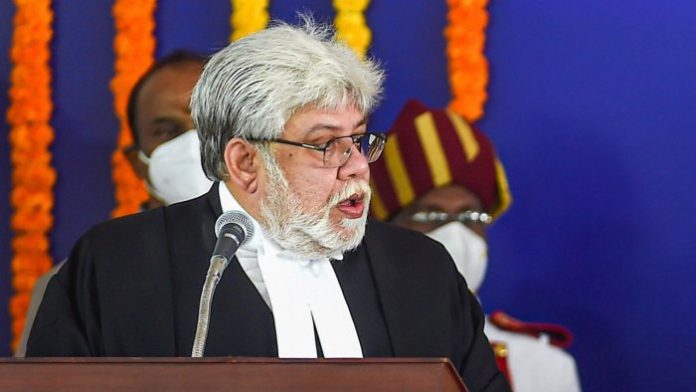Madras High Court advocates announces peaceful protest at Gavin gate entrance of High Court on Monday November 15 .
The Supreme Court Collegium had earlier recommended the transfer of Chief Justice Sanjib Banerjee to the Meghalaya High Court.
The collegium headed by Chief Justice Ramana, in its meeting held on September 16, had also recommended the transfer of Justice Munishwar Nath Bhandari of the Allahabad High Court to the Madras High Court.
Earlier at November 11, Opposing the transfer of Madras High Court Chief Justice Sanjib Banerjee to Meghalaya, over 237 advocates of the Madras High Court have signed a representation to the Chief Justice of India, N V Ramana and the Supreme Court Collegium, seeking to reconsider the decision to shift CJ Banerjee.
The representation, running to 12 pages, was signed by 237 advocates, including senior advocates R Vaigai and V Prakash. Advocates NGR Prasad and Sudha Ramalingam among others had also signed the letter.
The addressed to the Chief Justice with copies to other collegium members, described the transfer proposal as a “punitive measure” against “an honest and fearless judge.”
Highlight of the representation includes :
The transfer of Chief Justice Banerjee from the chartered Madras High Court with a sanctioned strength of 75 judges to the High Court of Meghalaya, established in 2013, with a current strength of just two judges, raises disconcerting questions, it said.
CJ Banerjee has consistently sought accountability from authorities at all levels in their discharge of constitutional and statutory duties. He is known to be impartial, open to suggestions from all quarters for improving the functioning of the justice system and has undertaken proactive measures to strengthen the judiciary, the representation said.
While transfers for better administration of justice may be necessary in principle, members of the Bar have a right to know why a “competent, fearless judge and an efficient administrator of a larger High Court, where more than 35,000 cases were filed in a year, should be transferred to a Court where the total number of cases instituted in a month is on an average of 70-75 cases only,” it asked.
It is to noted Justice Banerjee assumed the office of the Chief Justice of the Madras High Court on January 4, 2021 and is expected to retire in November, 2023.
Interestingly Justice Vijaya K Tahilramani, who was the Chief Justice of the Madras High Court in 2019, was transferred to the same Meghalaya High Court and she resigned. To register her protest against her transfer to Meghalaya High Court and the rejection of her plea to reconsider the matter, she had put in her papers on September 6 and the same was accepted by the President of India on September 20, 2019.
The representation to CJI further said short tenures and abrupt transfers stand in the way of a cohesive leadership and meaningful administrative reforms.
A change in leadership every few months will have an adverse impact on not just the administrative functioning of the High Court, but crucial decisions to be taken by the High Court Collegium will be delayed or suffer from the loss/lack of experience that is gained over several months, the advocates averred.
The Collegium of the Supreme Court had resolved to recommend the transfer of Justice Banerjee on September 16 this year. But this decision was made public only on November 9.
It is known in legal circles in Tamil Nadu that in order to ensure a totally free and independent judiciary, inquiries were afoot under the tenure of Chief Justice Banerjee to check corruption in the judiciary.
His intolerance for corruption and inefficiency is well known and widely appreciated. The instant transfer would quell any such effort to strengthen the judiciary in the State, it said.
Historically transfers have been used to move upright and honest judges who passed orders against the executive to “safer” and “less important” locations.
Such “punishment transfers”, as they came to be known during the infamous Emergency, send out an alarming signal that honest and fearless judges are subjected to political retribution and independence of the judiciary is under threat, the letter said.
Whether it is “punishment transfer” or “punitive transfer” it is important that the reasons for the transfer of any judge should be made transparent in public interest, for the public ought to know if a judge is being victimised for his fearless actions or is being punished for his inconvenient actions, the representation added.
“We are, therefore, writing this as responsible members of the Bar, being cognisant of the necessity to insulate the judiciary from any external interference, only to ensure that the independence of the judiciary does not suffer any threat. Unfortunately, the decision of the Supreme Court Collegium and the opacity around it seem to set alarm bells ringing amidst the public and all participants in the justice system.”
” Lack of transparency and opacity in the functioning of the Collegium tend to erode the faith of the public in the functioning of the justice system. Former judges, legal scholars and jurists had been expressing their concern that the Apex Court has been functioning as an ‘executive court.’ While there has been a refreshing change in perception in recent times, this gain should not be lost by an administrative decision such as this,” the communication added and urged the collegium to reconsider its proposal.









